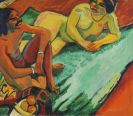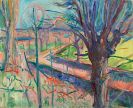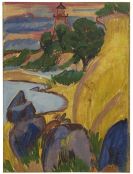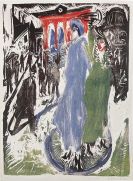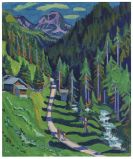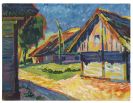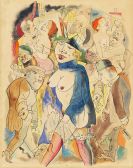
Bruno Goller
Gummersbach
1901 -
Düsseldorf
1998
Bruno Goller was Born in Gummerbach, Germany, on November 5, 1901. When still an adolescent, Goller began to paint autodidactically. In 1919 he became a student of the landscape painter Julius Jungheim in Düsseldorf. In 1927 Goller joined the artists' group "Das junge Rheinland" and participated in one of the group's exhibitions for the first time. Presumably the very same year, he got acquainted with the circle surrounding the legendary "Mutter Ey" and the Rhineland Avant-garde of the time.
In 1928 Bruno Goller was one of the co-founders of the "Rheinische Sezession". In 1930 he left the group to take part in exhibitions of the "Rheingruppe".
During Nazi rule in Germany, Goller's financial situation worsened increasingly. Due to growing political pressure, he retreated more and more and painted hardly any pictures. In 1940 he was drafted to serve in the military in France.
In 1943 his Düsseldorf studio was destroyed in an air raid. With the exception of a few paintings, all his works stored there were destroyed.
When Goller returned from war and captivity two years later, he went back to Düsseldorf, where he was appointed professor at the "Staatliche Kunstakademie" in 1953. In 1958 the "Kestner-Gesellschaft" in Hanover showed a first retrospective, followed by a second one at the "Städtische Kunsthalle Düsseldorf" in 1969.
Some of Goller's paintings were shown at "documenta II" in 1959. In 1965 Bruno Goller represented the Federal Republic of Germany at the VIII Biennale in São Paulo with 35 paintings. Bruno Goller received numerous awards, such as the "Großer Preis für Malerei" in North Rhine-Westphalia and the "Großes Verdienstkreuz des Verdienstordens der Bundesrepublik Deutschland".
Bruno Goller died in Düsseldorf in 1998. Independent from the artistic current of his time, Goller developed a distinctive image language, in which he continuously stuck to his motifs, which were influenced by his mother's hat shop throughout his life. He was interested in the objects of daily use decorating the shop windows such as coffee cups, hats and umbrellas. He detached the objects from their contexts, isolated them and removed any kind of individuality to cause a monumentalization of these everyday objects.
Would you like to sell a work by Bruno Goller?
Infos for seller
